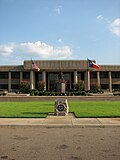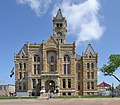
This is a list of county courthouses and other non-federal courthouses in Texas, both current and former. For federal courthouses located in Texas, see List of United States federal courthouses in Texas.
Contents
The U.S. state of Texas has 254 counties, the most of any U.S. state. County borders and sizes were essentially set so that a courthouse would be within one day's travel, which, given slow transportation, meant many counties. [1] The county courthouse system in the Republic of Texas was developed in 1845, which were designed to house government offices, a courtroom, and a jail. After statehood, Texas county courthouses kept their powers. [2]
The counties of Texas were often first served by a tree, tent, or other buildings before judicial functions moved into a log cabin or dugout. [3] During the later 19th century, most county courthouses were simple wooden or stone two-story rectangular buildings. [4] Due to difficulties during the Civil War and Reconstruction, no new courthouses were built until the late 19th century, when a large number were constructed. [4] Architect James Riely Gordon built 18 county courthouses, 12 of which survive; Wyatt C. Hedrick built 7. [5] Other architects from this time period included Atlee Ayres, Nicholas J. Clayton, W.C. Dodson, Alfred Giles, Eugene T. Heiner, and Frederick and Oscar Ruffini. [4]
Another wave of courthouse buildings occurred during the early 20th century, as the statewide economy boomed and transportation infrastructure expanded. Architects of this period included David S. Castle, Lang & Witchell, and Charles Henry Page. [6] Courthouses were also common Works Progress Administration (WPA) projects during the Great Depression. During this time, numerous courthouses were expanded and remodeled. [7]
Texas courthouses often reflect the architectural styles that were popular at the time they were built. Many of the surviving Late Victorian Era courthouses have Romanesque Revival, Renaissance Revival, Neoclassical, and Second Empire features. [5] [8] While some of these styles persisted into the 20th century, newly-developed styles, such as Beaux-Arts and Mission Revival, began to be incorporated. [6] During the WPA's projects, many courthouses were replaced or remodeled with Moderne, Stripped Classicist, International, and Art Deco elements. [9] Finally, the most recent courthouses and expansions are designed in the Modern and Brutalist styles. [10]
Government buildings were often constructed around a central plaza or public square, which became a center of town life and economy, and this layout has persisted. [11] Several of the squares include statues, war memorials, and historic trees on the grounds; many also function as markets. [12]
Many original structures have been lost to fire, including those in Austin, Hill, Mason, and Newton counties. [5] [13] Arson has been suspected or confirmed in some cases. [14] The oldest continuous site still inhabited by a county courthouse is in Liberty County, where its courthouse has stood—although rebuilt—since 1831. [15]
In 1971 and 1972, two Texas Courthouse Acts were passed, which require the county to notify the Texas Historical Commission (THC) of any plans to remodel or destroy historic courthouses. [16] The THC's Courthouse Preservation Program funds restoration works on historic courthouse buildings. [17]











































































































































































































































































